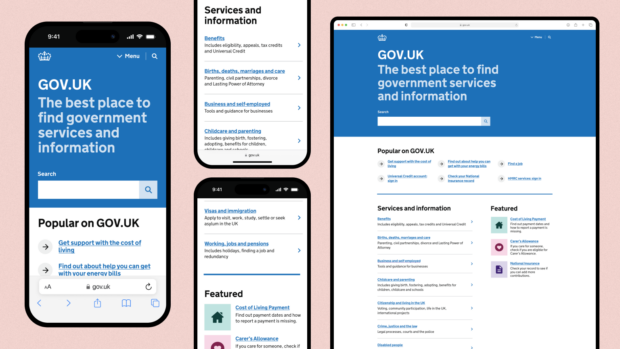The relaunched annual GDS event shone a light on the government’s key digital-transformation strategies and initiatives for the coming months and years. PublicTechnology went along to find out more
Credit: GDS
After missing a year in 2017, the Government Digital Service’s annual Sprint event was back this week.
About 700 delegates from across the civil service, the wider public sector, and beyond gathered at London’s Southbank Centre to talk to their peers and hear from a range of speakers about the future of digital public services.
Attendees were given the chance to discover what GDS, and others, have been up to in recent months, and find out more about how the UK’s digital-government agenda will develop in the next 12 months, and into the years ahead.
No more than a couple of minutes in, the first thing we learned – which is not included in the ‘six things’ specified in the headline, so is a free gift for all PublicTechnology readers – was that the event’s host, GDS head of content design Trisha Doyle, is a far more accomplished compere than she is a self-photographer. As evidenced by the composition of the photo being taken in the picture above.
Doyle’s – otherwise impeccable – introduction was just the start of a day of discovery.
So, here’s what we found out:
1. There are 400 service areas that are set for transformation
Throughout the day, a big focus of Sprint 18 was end-to-end services.
That is to say, services that take as their starting point a user’s ultimate goal – such as opening a business – then work to create a step-by-step journey that guides them there. This approach will typically necessitate differing organisations working together to build processes that allow citizens to interact with government as if it were a single entity – rather than a collection of disparate departments.
About five such services have been built so far, including the Learn to drive a car site, on which the DVSA and DVLA worked together to build a six-stage process to help citizens go from checking whether they are allowed to learn, right through to what they should do once they pass their driving test.
GDS has identified 400 services it believes could be redesigned in this way, and transformation work will begin in the coming months.
And, given that government offers in excess of 10,000 different citizen services, the work that has been done in this area so far could be just the tip of the tip of the iceberg.
“Work like this improves life for people: they have a good user experience, they understand the task they have to do, they can then get on with their day. It fulfils our purpose as a government. We are enabling people to interact with government in the most straightforward way. It saves money and it improves the reputation of government: both in the minds of citizens but also around the world – this work breaks new ground.
“Step-by-step navigation can take people through every major life event: from buying a home to filing tax returns to planning for retirement. And perhaps [someone] might want to give back to the community by organising a street party to celebrate an upcoming royal wedding, for example: the process of applying to your local council to hold one could well be a step-by-step process on GOV.UK.”
Oliver Dowden, minister for implementation
2. Signing a digital mortgage has a built-in delay
HM Land Registry’s new digital mortgage service – which saw its first deed virtually signed last month – makes it quicker and easier for people to buy a home.
But, while the service was being developed, user-testing revealed that some found it just a little too quick and easy. 
As test users clicked the final click to make everything official, many reported that they were perturbed by the fact that they were instantaneously taken to the confirmation screen.
Surely such a momentous – and hugely expensive – life event takes even the most overclocked laptop a few moments to process…?
Thus, a brief loading screen that informs users it will take 10 seconds to process their mortgage has been built in at the last stage of the service.
But the addition is nothing more than aesthetic – with the service itself still designed to be as safe as houses.
3. Seven times as many people are checking their pension forecast each month
When the state pension forecast digital service was launched in early 2016, about 80,000 people each month typically used the equivalent paper-based service.
During the opening month of 2018, a record-breaking 613,000 people received from the Department for Work and Pensions a forecast of how much they can expect in state-pension payments, and when. This equates to a more-than-sevenfold increase in service usage levels.
Although some paper users remain – about 30,000 a month, on average, compared with about 500,000 online users – most have switched to the digital platform. And hundreds of thousands more have begun using the service for the first time since it went online.
The digital service, which has a user-satisfaction rate of 88%, has been used a total of 8.5 million times since its creation.
4. The civil service has a range of new DDaT development programmes – including AI
GDS is leading the process of rolling out two new civil-service apprenticeships in the digital, data and technology sector for software engineers and business analysts.
About 25 software engineering apprentices will shortly be joining the Whitehall ranks, while applications are still being filtered for the business-analysis roles.
For established civil servants, an Emerging Technology Development programme is being launched. The 10-week scheme will offer training on AI and machine-learning technologies
GDS hopes that, after completing the programme, participants will go back into their departments and lead discussions – and, ultimately, implementations – in the area of emerging technology.
A limited pilot of the AI development scheme will kick off soon, after which GDS hopes to run a full course with a much bigger cohort of students.
The wider framework of 37 clearly defined civil-service DDaT roles could also see some additions in the coming months, as GDS continues to take in departmental feedback on what posts should be included. The aim is to make sure new roles are recognised, while maintaining a consistent framework of jobs that translates across departmental boundaries.
“Every department feeds into those 37 roles. If there are new roles, we want to add them over time. But the whole approach is about ensuring that these are common roles across departments. We want to grow, and [the framework] will no doubt increase over time. But we do not want to create hundreds of roles unnecessarily.”
Holly Ellis, director of capability for DDaT profession, GDS
5. Usage of Verify has more than tripled in the past six months
Two years on from its launch, the GOV.UK Verify identity-assurance service has 2.2 million accounts – still quite some way short of the theoretical 25-million-user target that has  been set for 2020.
been set for 2020.
However, existing users are, at least, making use of the service an awful lot more in recent months.
As of now, Verify has been used to secure a total of more than six million transactions conducted by citizens. But, just six months ago, the figure was only 1.7 million.
The service will increasingly look to drive uptake via private-sector partners, according to Nic Harrison, who heads up GDS’s Verify operations.
6. GOV.UK is looking at voice activation – but only looking at this stage
GDS is looking at how voice-recognition platforms from the likes of Microsoft, Google, and Amazon could be implemented to help users navigate the GOV.UK site.
An on-stage demonstration – incorporating the use of Google Assistant – showed how GOV.UK’s content for the relaunched learn-to-drive service has been designed to work with voice recognition-based tools.
But these are just early forays and, while exploration will continue, the jury is still out on how necessary voice-compatibility is for the wider government digital landscape at this moment in time.
GDS researchers will, in the coming months, examine how, why, and to what extent people are using voice platforms to find information on GOV.UK. The ultimate goal is to come up with a plan that can serve the whole of government – rather than taking a piecemeal, service-by-service approach.
“It is still very early for this technology, and the use cases are not terribly clear. What are people looking for by voice? Our first step is that we have a team looking at this. We could go and build Alexa or Cortana skills for [individual services] – but we want to do this at scale for the whole of government.”
Neil Williams, head of GOV.UK, GDS



